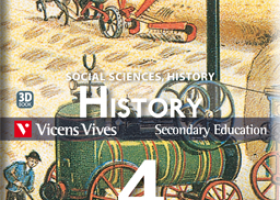History 4. Social sciences, History
1. The 18th century: the Ancien Régime in crisis
2. Liberal revolutions and nationalist movements (1789-1871)
3. The industrialisation of European societies
4. Spain in the 19th century: building a liberal regime
5. Society and industrialisation in 19th century Spain
G. Glossary
6. The age of imperialism
7. Art in the 19th century
8. The First World War and the Russian Revolution (1914-1939)
9. [...]
Este libro contiene:
-
18 secuencias
-
1245 recursos
-
Idioma:
- Inglés
Libro de texto
-
1. The 18th century: the Ancien Régime in crisis
- Ir a ficha de secuencia
- 0 secuencias
- 88 recursos
In the early 18th century, the Ancien Régime was the dominant political and social system in Europe. It was made up of an absolute monarchy, a social structure based on the estates of the realm and a rural economy. However, rapid demographic and economic growth saw the middle classes grow in this period. This led to the Age of Enlightenment. [...]
-
2. Liberal revolutions and nationalist movements (1789-1871)
- Ir a ficha de secuencia
- 0 secuencias
- 89 recursos
The Enlightenment movement and economic growth in the 18th century prompted a period of profound political change in Europe. It led to the bourgeois revolutions, which saw liberalism spread through most of the continent. The English political system, the independence of the United States of America and, above all, the French Revolution provided the model for the new liberal and democratic party programmes. [...]
-
3. The industrialisation of European societies
- Ir a ficha de secuencia
- 0 secuencias
- 92 recursos
Between 1780 and 1850 there was a major transformation of goods production systems: the Industrial Revolution. It started in Britain, and then spread to Europe and the United States of America. Following the introduction of energy sources, coal and steam, machines gradually started to replace manual labour. Industrial capitalism emerged, based on the private ownership of production systems and free enterprise. [...]
-
4. Spain in the 19th century: building a liberal regime
- Ir a ficha de secuencia
- 0 secuencias
- 87 recursos
During the 19th century, Spain dismantled the Ancien Régime in favour of a liberal state. Napoleon's invasion (1808-1814) led to some early attempts at introducing liberal ideas into Spain. However, it was only on the death of Ferdinand VII (1833) that liberalism became firmly integrated into Spanish politics. As liberalism took hold in Spain, the monarchs lost much of their power to constitutions and the parliament. [...]
-
5. Society and industrialisation in 19th century Spain
- Ir a ficha de secuencia
- 0 secuencias
- 85 recursos
In 19th century Spain, the Ancien Régime was replaced by an economic model based on industry and capitalism. The feudal society became a class society defined by property and wealth. However, industrialisation was slow in Spain, and at first only reached some regions (Catalonia, the Basque Country and Madrid). Spain remained a largely agricultural country with many farmers, a weak industrial bourgeoisie and a small proletariat class. [...]
-
6. Glossary
- Ir a ficha de secuencia
- 0 secuencias
- 5 recursos
Absolute monarchy (n): a system of government where the king or queen alone has all the power. Ancien Régime (n): the social and political system in France before the 1789 Revolution. bill of rights (n): a statute which guarantees the rights of the individual citizen. Bourbon centralism (n): the control and government of a country by a single group; favoured by the Bourbons. [...]
-
7. The age of imperialism
- Ir a ficha de secuencia
- 0 secuencias
- 75 recursos
By the year 1870, the industrialised nations had entered a period of economic prosperity and demographic growth due to advances made during the Second Industrial Revolution. The major European powers, now far superior to the rest of the world in terms of technological advances and financial and military strength, began to conquer new territories. [...]
-
8. Art in the 19th century
- Ir a ficha de secuencia
- 0 secuencias
- 79 recursos
The end of the 18th century marked a transition from Rococo art, which embodied the aesthetics of the Ancien Régime, to neoclassicism. Neoclassicism was based on the classical art and culture of Ancient Greece and Rome, and on rationality. Art in the 19th century reflected the social and political transformations of the time. [...]
-
9. The First World War and the Russian Revolution (1914-1939)
- Ir a ficha de secuencia
- 0 secuencias
- 89 recursos
At the beginning of the 20th century, economic rivalry between the nations and the colonies led to an increase in tension amongst the European states. An arms race began that eventually led to the outbreak of the First World War. This was a new type of conflict that involved many different countries. It mobilised not only armies but also civilians, and brought widespread death and destruction. [...]
-
10. Crisis of the democracies and the Second World War (1919-1945)
- Ir a ficha de secuencia
- 0 secuencias
- 101 recursos
The period 1918-1939 was an age of great political and economic instability. The First World War had destabilised Europe's economy and the United States of America was now the world's leading economic power. Then, after a period of economic euphoria (known as the 'Roaring Twenties), the New York stock market crashed in 1929, triggering a major economic depression that spread to Europe and other parts of the world. [...]
-
11. A time of conflict in Spain (1902-1939)
- Ir a ficha de secuencia
- 0 secuencias
- 86 recursos
Under the rule of Alfonso XIII at the beginning of the 20th century, the dynastic parties' reform attempts failed. Taking advantage of the ensuing political crisis, Primo de Rivera established a military dictatorship in 1923. In 1931 Spain was declared a republic. Alfonso XIII went into exile. [...]
-
12. Glossary
- Ir a ficha de secuencia
- 0 secuencias
- 5 recursos
Acculturation (n): adoption of the ways of a different culture. agricultural products (n): things that are grown in large quantities to be sold. balance of trade (n): the difference in value between a country’s exports and imports. Big stick (n): the threat of using force to get something. British East India Company (n): a private business which first traded with India and later ruled it. [...]
-
13. A bipolar world: the cold war and decolonisation (1945-1991)
- Ir a ficha de secuencia
- 0 secuencias
- 95 recursos
Between 1945 and 1991, the world was divided into two opposing blocs: the Eastern Bloc (socialism), led by the USSR and the Western Bloc (capitalism), controlled by the United States of America. Western Europe and Japan supported the Western Bloc, while the Soviets had the support of Eastern Europe and Third World countries undergoing socialist revolutions. [...]
-
14. Spain under Franco (1939-1975)
- Ir a ficha de secuencia
- 0 secuencias
- 70 recursos
Franco's victory in the Civil War led to the creation of a fascist-style dictatorship. The traditionalist sectors (the armed forces, the Church and the Falange) had close links with the dictatorship. General Francisco Franco presided over this period (1939-1975) as an omnipresent figure. Social and political repression was one of the central pillars of his regime. The country's socio-economic situation went through several phases. [...]
-
15. Transition and democracy in Spain (1975-2012)
- Ir a ficha de secuencia
- 0 secuencias
- 70 recursos
Spain began the transition to democracy after Franco's death in 1975. At the end of Franco's rule sovereignty was returned to the people and a parliamentary monarchy established. Spain's first Constitution was passed by referendum in 1978. It called for a decentralised government, and declared Spain a state of autonomous communities. [...]
-
16. The world today
- Ir a ficha de secuencia
- 0 secuencias
- 63 recursos
The collapse of the USSR caused the East-West blocs to disappear, leaving the United States of America as the sole world superpower. As a result, capitalism has become the principal economic model, and this, alongside huge advances in information technology, has seen the world undergo a process of globalisation. [...]
-
17. Art in the 20th century
- Ir a ficha de secuencia
- 0 secuencias
- 61 recursos
The Impressionists and Post-Impressionists of the late 19th century had already planted the seed of experimentation, innovation and creativity. As a consequence, the art of the early 20th century did not aim to imitate reality, but rather promoted new artistic trends, collectively called the first avant-garde. After the Second World War, the centre of the artistic world moved from Paris to New York. [...]
-
18. Glossary
- Ir a ficha de secuencia
- 0 secuencias
- 5 recursos
Cold War (n): the state of political and military tension, but not actual war, between the Eastern and Western Blocs from the end of World War II to the 1990s. COMECON (n): an economic association of Eastern European countries which existed from 1949 to 1991. Common Market (n): another name for the European Economic Community, used in the 1960s and 1970s. [...]
Cursos y asignaturas
-
Inicia sesión o Únete a Tiching para poder comentar
-
Hace 9 años
No puedo consultar nada.....
-
Hace 10 años
No se abre
La licencia digital es una autorización que permite utilizar un recurso digital de acuerdo con las condiciones legales de dicho recurso. El código que recibas una vez la hayas comprado te permitirá acceder al recurso educativo digital elegido.
Puedes consultar más información en nuestra página de ayuda.





























¿Dónde quieres compartirlo?
¿Quieres copiar el enlace?